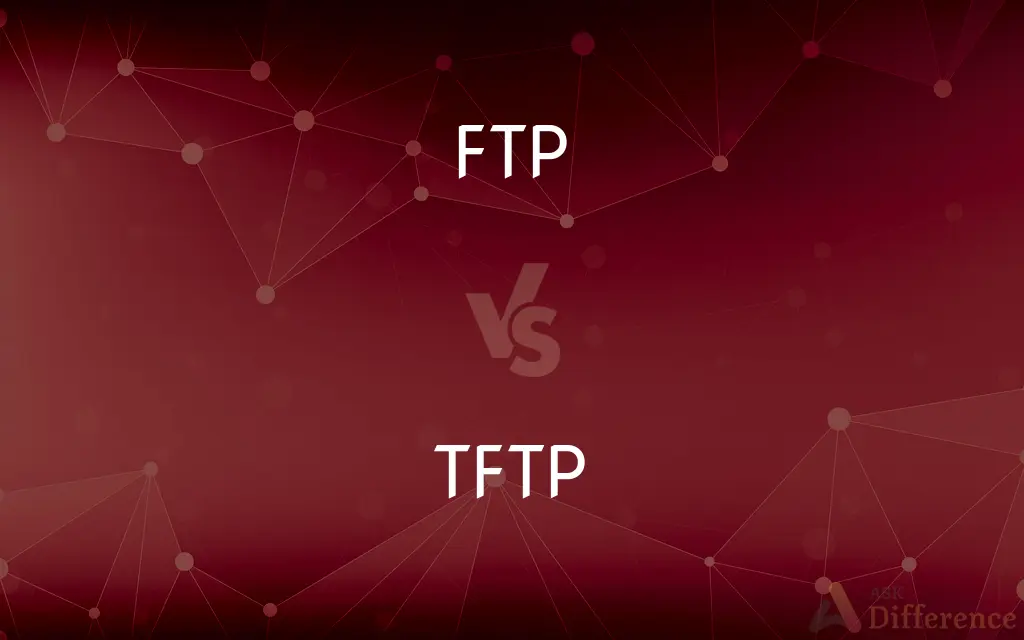FTP vs. TFTP — What's the Difference?
Edited by Tayyaba Rehman — By Fiza Rafique — Published on January 1, 2024
FTP is a complex file transfer protocol with user authentication, while TFTP is a simpler, unsecured protocol without authentication, often used for booting devices or simple transfers.

Difference Between FTP and TFTP
Table of Contents
ADVERTISEMENT
Key Differences
FTP (File Transfer Protocol) is a comprehensive protocol used for transferring files over a network that requires user authentication, typically through a username and password. It operates over TCP, allows encrypted transfers, and provides extensive command options for file handling and directory navigation. FTP servers usually maintain logs for monitoring data transfers.
TFTP (Trivial File Transfer Protocol), in contrast, is a much simpler protocol designed to send and receive files without the need for user authentication. It is typically used for transferring small amounts of data within a local network, especially for booting network devices like routers. TFTP uses UDP, which is faster but less reliable than TCP, as it does not establish a connection before sending data and doesn't have built-in error correction.
While FTP is a well-established protocol suitable for secure and reliable file transfers over the internet, TFTP's simplicity makes it unsuitable for complex tasks or secure transmissions. FTP provides features like file resume, directory listing, and various file manipulation commands. It is widely used for downloading files from the internet where secure authentication and data integrity are required.
TFTP is stripped of most features found in FTP, lacking directory browsing capabilities, and it does not provide any form of encryption, which makes it a poor choice for transferring sensitive data. However, its simplicity means that it requires less overhead and can be more efficient in environments where security and a comprehensive feature set are not necessary.
Each protocol serves different needs: FTP is robust and secure, ideal for managing files on remote servers; TFTP is lightweight and fast, optimized for simple file transfers in a trusted local environment. Therefore, choosing between FTP and TFTP depends on the specific requirements of the file transfer task at hand.
ADVERTISEMENT
Comparison Chart
Protocol Type
Complex, feature-rich.
Simple, feature-light.
Transport Protocol
Uses TCP for reliable delivery.
Uses UDP, which is faster but less reliable.
Authentication
Requires authentication.
Does not require authentication.
Usage
Suitable for secure file transfers.
Used for simple transfers within local networks.
Error Handling
Has error correction capabilities.
Lacks error correction, relies on simplicity.
Commands
Offers a range of commands.
Offers minimal commands.
Security
Supports encryption.
No built-in security features.
Compare with Definitions
FTP
FTP allows for command-line or graphical interface operations.
I prefer using a graphical FTP client for easier file management.
TFTP
TFTP is designed for simplicity with minimal memory footprint.
TFTP is ideal for small devices with limited storage and processing power.
FTP
FTP is a network protocol for transferring files securely between computers.
I used FTP to upload the website files to the server.
TFTP
TFTP uses UDP for communication, making it faster but less reliable.
TFTP's use of UDP means no connection overhead, perfect for quick transfers.
FTP
FTP operates over TCP/IP for reliable data transfer.
The FTP protocol ensures that my files arrive intact.
TFTP
TFTP is often used in applications where devices need to be booted remotely.
Our network switches are configured to retrieve their OS via TFTP.
FTP
FTP can handle large file transfers efficiently.
FTP is great for downloading large software packages.
TFTP
TFTP is a lightweight protocol used primarily for bootstrapping and simple file transfers.
We use TFTP to load the initial boot images on our thin clients.
FTP
A communications protocol governing the transfer of files from one computer to another over a network.
TFTP
TFTP lacks built-in security, offering no authentication.
Because TFTP has no security, it should only be used in a trusted network.
FTP
To transfer (a file) using FTP.
FTP
To transfer a file using FTP.
FTP
An acronym for file transfer protocol, a standardized protocol used to allow transmission of files between computers; as, send me the file by ftp. It consists of a set of coded signals which are transmitted between computers, and which inform the receiving computer of the nature of a packet of information to be transmitted, and inform the transmitting computer when a packet has been successfully received.
FTP
To send from one computer to another by means of the standard file transfer protocol (ftp); as, he ftp'd me the file yesterday.
FTP
Protocol that allows users to copy files between their local system and any system they can reach on the network
FTP
Use the File Transfer Protocol to transfer data from one computer to another;
You can FTP these data
FTP
FTP requires user authentication for access.
You'll need the correct FTP login to access those files.
Common Curiosities
Does FTP use TCP or UDP?
FTP uses TCP for data transfer, ensuring reliability.
What does FTP stand for?
FTP stands for File Transfer Protocol.
Is FTP secure?
FTP can be secure, especially when used with encryption like FTPS or SFTP.
What protocol does TFTP use?
TFTP uses UDP, which is less reliable but faster due to less overhead.
Can you browse directories with TFTP?
No, TFTP does not support directory browsing.
Can TFTP be used for secure transfers?
No, TFTP lacks security features and is not suitable for secure transfers.
What does TFTP stand for?
TFTP stands for Trivial File Transfer Protocol.
Why would I use TFTP over FTP?
Use TFTP for simple, local file transfers where speed and simplicity are priorities over security.
What port does FTP use?
FTP commonly uses port 21 for control commands.
What port does TFTP use?
TFTP commonly uses port 69.
Do I need special software to use FTP?
Yes, you need an FTP client to use FTP services.
How does TFTP handle data corruption?
TFTP has basic error detection and will retransmit corrupted packets.
Does FTP support anonymous access?
FTP can be configured to allow anonymous access, though it's not default.
Are FTP and TFTP interchangeable?
No, they serve different purposes and are not interchangeable.
Can I password protect a TFTP server?
TFTP does not support password protection inherently; any security must be implemented externally.
Share Your Discovery

Previous Comparison
Armani vs. Armani Exchange
Next Comparison
Data Hiding vs. EncapsulationAuthor Spotlight
Written by
Fiza RafiqueFiza Rafique is a skilled content writer at AskDifference.com, where she meticulously refines and enhances written pieces. Drawing from her vast editorial expertise, Fiza ensures clarity, accuracy, and precision in every article. Passionate about language, she continually seeks to elevate the quality of content for readers worldwide.
Edited by
Tayyaba RehmanTayyaba Rehman is a distinguished writer, currently serving as a primary contributor to askdifference.com. As a researcher in semantics and etymology, Tayyaba's passion for the complexity of languages and their distinctions has found a perfect home on the platform. Tayyaba delves into the intricacies of language, distinguishing between commonly confused words and phrases, thereby providing clarity for readers worldwide.














































